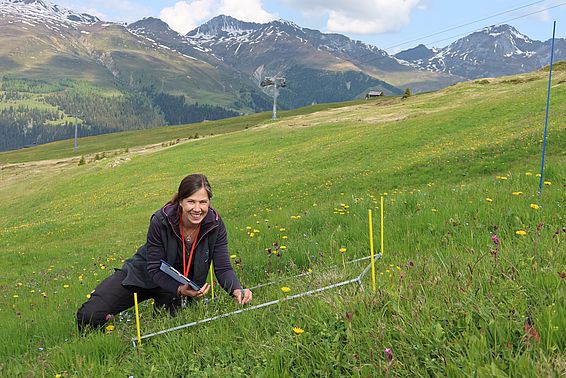27.06.2023 | Jochen Bettzieche | News SLF
Biodiversity on the Jakobshorn – SLF biologists are studying the interaction between plants and their predators.
Anne Kempel, a biologist from the SLF's mountain ecosystems research group, picks a clover and points to some small holes: "Those were made by an insect." Then she holds up another leaf, discoloured to a rusty brown: "And this is a rust fungus. Pretty, isn't it?" She also enthuses about the tunnels created by fly larvae in leaves.
Kempel is sitting in a flower meadow above the Clavadeler Alp on the slopes of the Jakobshorn, but she has little time for the magnificent mountain scenery. Instead, she is bending over a metal frame, magnifying glass in hand, busily identifying flowers and grasses. She has marked out her test plot with blue and yellow sticks, the colours of the commune Davos. Biodiversity is an issue that is currently on the minds of many, and the biodiversity here is particularly striking. "We want to understand how this meadow works and how it will change in the face of climate change," says the biologist.
If there were only plants on this site, over time one species would prevail. But a glance at her plot shows that this is not what is happening. A dazzling array of flowers, including yellow buttercups, blue gentians, light-blue forget-me-nots and many others, form a colourful spring mountain meadow. The fact that no single species dominates is due to the plants' predators: insects, slugs and snails, and fungi. These ensure a balanced mix of flora on the slope. "So far, though, no one has examined in detail how important these three predator types are for biodiversity and ecosystems," says Kempel, explaining the motivation for her research. Her work is part of the activities of the international "Bug-Network" (BugNet), in which researchers are investigating the same question at 40 sites from Scandinavia and Greece to South America and New Zealand. All the investigated areas are a uniform size, divided into 24 plots of 25 square metres each. Some of them are without insects, some without slugs and snails and some without fungi, while others host combinations of these, and there are also control areas where all three species occur undisturbed.
Using this approach, researchers aim to investigate a range of details and acquire globally valid insights. Kempel gives an example: "If we exclude all predators, will some plant species prevail and will biodiversity decline?"
In Davos, she has three investigation sites: on the Jakobshorn, above the Clavadeler Alp and in the valley. This means she can also research the effects of local temperature differences. "We also want to use special warming chambers to analyse how our mountain meadows will change as temperatures rise due to climate change," says Kempel.
It will be at least five years before the final results are available. Until then, she will visit the sites on a regular basis, mowing the meadow in early summer. From spring onwards, when the snow has melted, she will go once a month to remove slugs and snails, insects and fungi from the plots, and once a year to carry out the analysis. This is when the researchers count and identify plants and animals. To avoid missing any animals, Kempel explains that the researchers use a rather unusual method: "We take a vacuum cleaner to the meadow and use it to collect all the insects."
This article first appeared in the Davoser Zeitung on 27th June 2023.
Contact
Copyright
WSL and SLF provide image and sound material free of charge for use in the context of press contributions in connection with this media release. The transfer of this material to image, sound and/or video databases and the sale of the material by third parties are not permitted.
